What Are Digital Marketing Tactics?
Digital marketing tactics are specific, actionable steps you take to implement your marketing strategy. These tactics translate your strategy into measurable actions that drive results.
Use our curated list of digital marketing tactics below to grow your business’s online presence, attract more customers, and boost engagement.
1. Optimize Your Content for AI Visibility
Related Discipline: Content Marketing
Effort Required: Primarily time to update existing content; some financial investment may be needed to create new, optimized content.
As AI tools like ChatGPT, Google’s AI Overviews, and Perplexity become key ways people discover information, optimizing your content for these platforms is crucial. By doing so, you increase your chances of reaching a broader audience and staying ahead of competitors.
According to Semrush data, AI-driven tools—including Google’s AI Overviews and AI Mode—are projected to drive more traffic to websites than traditional organic search by 2028.
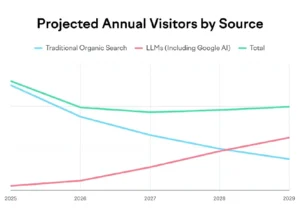
Optimizing for AI search is increasingly important for business owners who want to expand their online visibility and reach a wider audience.
Here are some effective ways to optimize your content for AI-powered tools:
Write One Main Idea Per Paragraph
Keep each paragraph short and focused on a single concept so AI systems can easily extract the most relevant information for a user’s query.
Focusing on one idea per paragraph not only helps AI better understand your content but also improves the user experience. Always aim to put your most important point first.
Instead of:
“Email marketing is another useful tactic for business owners. It offers good ROI compared to other channels, and allows for personalization and segmentation. This makes it valuable for customer retention and driving repeat purchases.”
Write:
“In one study, 35% of marketing leaders said email marketing generates an ROI of $10 to $36 for every dollar spent. This makes it one of the most cost-effective digital marketing channels available.”
Then, provide additional details—such as personalization and segmentation—in separate paragraphs.
Answer Questions Directly
When addressing common questions, lead with clear, definitive answers. AI tools (and users) prefer direct responses over vague explanations.
Under every heading, answer the question it asks (or implies) in the first line, then follow it with supporting information, examples, or data. This approach is known as the Bottom Line Up Front (BLUF) technique.
Example:
When writing about reciprocal links, start with the answer immediately, then provide further explanation and context below.
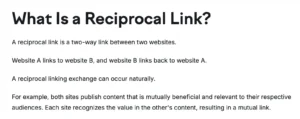
Notice how we immediately answer the question posed by the heading before providing an example.
Giving a direct answer right away increases the chances of your content being featured in AI-generated responses. For example:
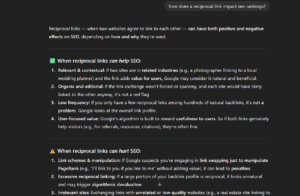
Include Original Data That’s Quotable
Present your original data in clear, standalone statements that AI tools can easily extract, and always use numbers where relevant.
Instead of:
“A study we conducted shows that most businesses find email marketing effective for customer acquisition.”
Write:
“According to our study of 1,000 business owners, 67% of small businesses say email marketing is their most effective customer acquisition channel.”
Creating entirely new studies can also increase your chances of being cited by AI. For example, ChatGPT references our study on the impact of AI search as a source for relevant questions.
Use Structured Formatting
Organize your content in ways that are easy for AI tools to understand and cite:
-
Clear and descriptive headings to define sections
-
Numbered lists for processes and steps
-
Tables for comparisons and data
-
Short sentences and paragraphs
Tables work particularly well for pricing information, feature comparisons, or step-by-step instructions. Many AI tools—including Google AI Overviews—present information to users in these formats, so mirroring them in your content can improve your chances of being cited.
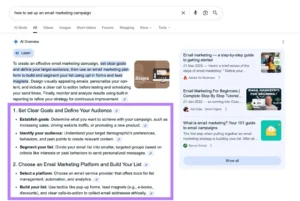
To track your AI visibility as you implement these optimizations, use Semrush’s AI SEO Toolkit.
It provides a clear overview of your current AI visibility and shows how you compare to your main competitors.
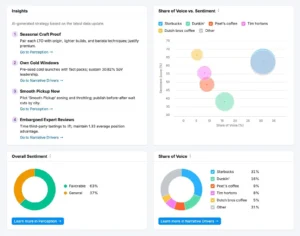
5 Digital Marketing Tactics That Still Work
Digital marketing tactics are specific, actionable steps you take to implement your marketing strategy. These tactics help you achieve measurable outcomes and grow your online presence. Below are five proven tactics to boost your business’s digital visibility and engagement.
1. Optimize Your Content for AI Visibility
Related Discipline: Content Marketing
Effort Required: Time to update existing content; some financial investment may be needed for new, optimized content.
As AI tools like ChatGPT, Google’s AI Overviews, and Perplexity become major ways people discover information, optimizing your content for these platforms is crucial. This helps you reach a broader audience and ensures your brand is visible in AI-driven search results.
Tips to Optimize Content for AI:
-
Write One Main Idea Per Paragraph: Keep paragraphs short and focused on a single concept so AI systems can extract the most relevant information. Put your key point first, then add supporting details.
-
Answer Questions Directly: Lead with clear answers under each heading, then provide supporting information. This Bottom Line Up Front (BLUF) approach improves chances of being featured in AI responses.
-
Include Original Data: Present your own data in clear, quotable statements. For example:
“According to our study of 1,000 business owners, 67% of small businesses say email marketing is their most effective customer acquisition channel.” -
Use Structured Formatting: Use descriptive headings, numbered lists, short paragraphs, and tables for comparisons or step-by-step instructions. AI tools often present information this way, so mirroring the format can increase your chances of being cited.
Monitor Your AI Visibility:
Use Semrush’s AI SEO Toolkit to track your AI visibility. It shows:
-
How your brand sentiment is performing in AI tools
-
Areas where you could improve
-
Prompts your competitors appear for that you don’t, highlighting topics to optimize
Optimize for AI Visibility → Sign Up Now
2. Create Short-Form Video Content
Related Discipline: Video Marketing
Effort Required: Moderate—planning, filming, and editing required. Start with a smartphone and free editing tools, then scale as needed.
Short-form videos for TikTok, Instagram Reels, and YouTube Shorts can help you reach a wider audience and repurpose existing content.
How to Create Effective Short-Form Videos:
-
Use the Right Formats: How-to guides, product comparisons, and quick tips answer common questions. Example: GetResponse posts short videos with quick tips and case studies.
-
Repurpose Long-Form Content: Break longer videos into short clips highlighting key points. Example clips:
-
“What Features the Best Email Marketing Platforms Have”
-
“5 Email Marketing Mistakes to Avoid”
-
-
Post on Multiple Platforms: Publish videos on 2–3 platforms where your audience is active. Use tools like Semrush Traffic & Market Toolkit to identify where your audience spends time.
3. Use Deep Audience Research Techniques
Related Discipline: Any Marketing Discipline
Effort Required: Moderate—gathering and analyzing audience data, then applying insights.
Understanding your audience helps you create content that attracts traffic, boosts engagement, and converts visitors into customers.
Ways to Conduct Audience Research:
-
Mine Customer Support Conversations: Review tickets, chat transcripts, and emails to identify recurring questions and pain points. Capture exact language customers use.
-
Analyze Online Communities: Monitor relevant subreddits, forums, and discussion boards to find questions, complaints, and language patterns.
-
Review Competitor Reviews: Look for patterns in what customers like or dislike about competitors’ products to identify content opportunities and product gaps.
-
Analyze YouTube Comments: Use AI tools like ChatGPT to extract main pain points and language from comments on your videos or competitors’ videos.
Insights from these sources can inform blog posts, product features, FAQs, and marketing copy.
4. Launch Retargeting Ad Campaigns
Related Discipline: Paid Advertising
Effort Required: Moderate financial investment; time for setup and optimization.
Retargeting ads let you reconnect with visitors who didn’t convert the first time.
How to Run Effective Retargeting Campaigns:
-
Install Tracking Pixels: Add pixels or tags to your website to track visitors and show them relevant ads across social media and websites.
-
Segment Your Audience: Create different retargeting lists based on behavior, e.g., all visitors, product page visitors, cart abandoners, blog readers.
-
Use Dynamic Retargeting: Automatically show ads featuring the exact products users viewed, improving relevance and conversion rates.
-
Exclude Converters & Set Frequency Caps: Avoid wasting budget on people who have already converted and prevent ad fatigue.
Platforms to set up retargeting campaigns include Google Ads, Meta Ads, and LinkedIn Ads.
5. Create Interactive Content
Related Discipline: Content Marketing
Effort Required: Moderate time and potential financial investment depending on complexity.
Interactive content engages users, encourages sharing, generates backlinks, and can drive conversions.
Ideas for Interactive Content:
-
ROI Calculators: Let users see potential savings or revenue from using your product. Example: Circle’s calculator estimates earning potential based on audience size and subscription fees.
-
Quizzes and Assessments: Provide personalized results based on user input. Example: Atlassian’s leadership style quiz delivers insights and links to additional resources, generating backlinks from high-authority domains.
You can also use gated content with email opt-ins to build qualified leads.
Use These Digital Marketing Tactics to Grow Your Business
Implement these tactics based on your current resources and business needs. For example, short-form video is great for repurposing existing content, while AI content optimization may be more feasible if you have limited video resources.
Track your AI visibility with Semrush’s AI SEO Toolkit to monitor performance and identify areas for improvement as you implement these tactics.